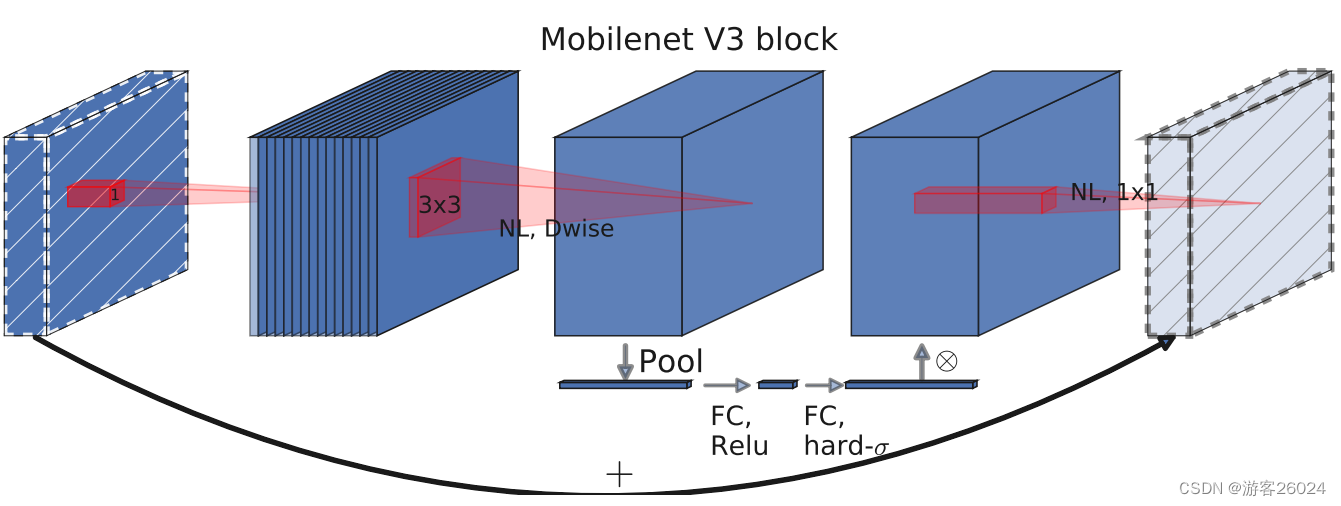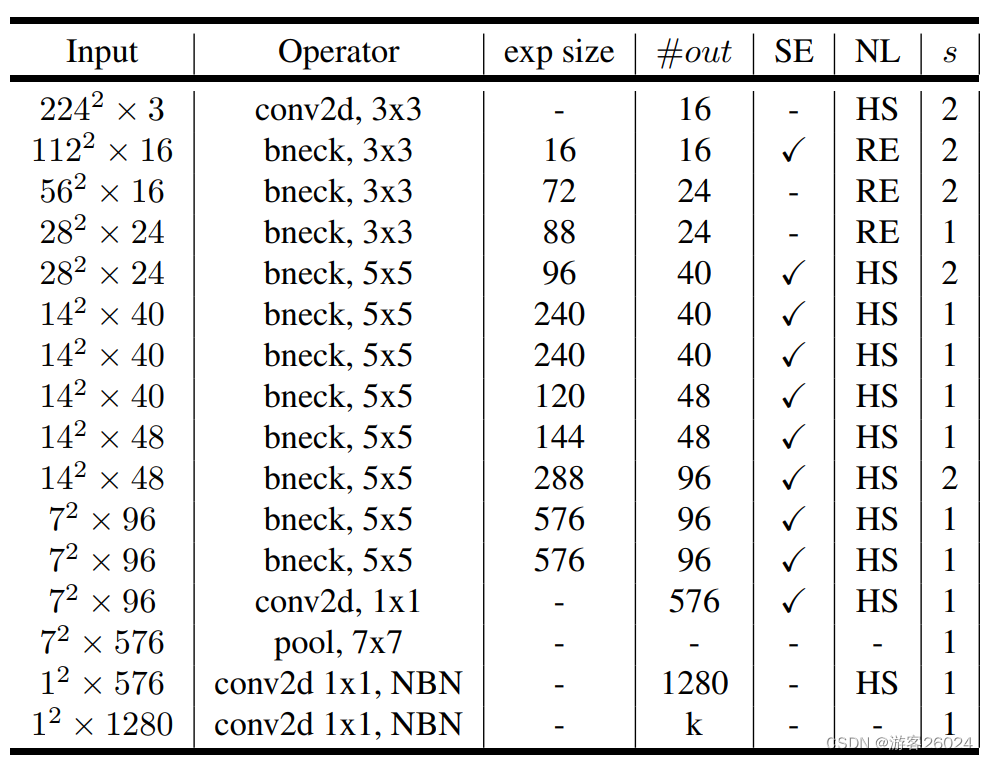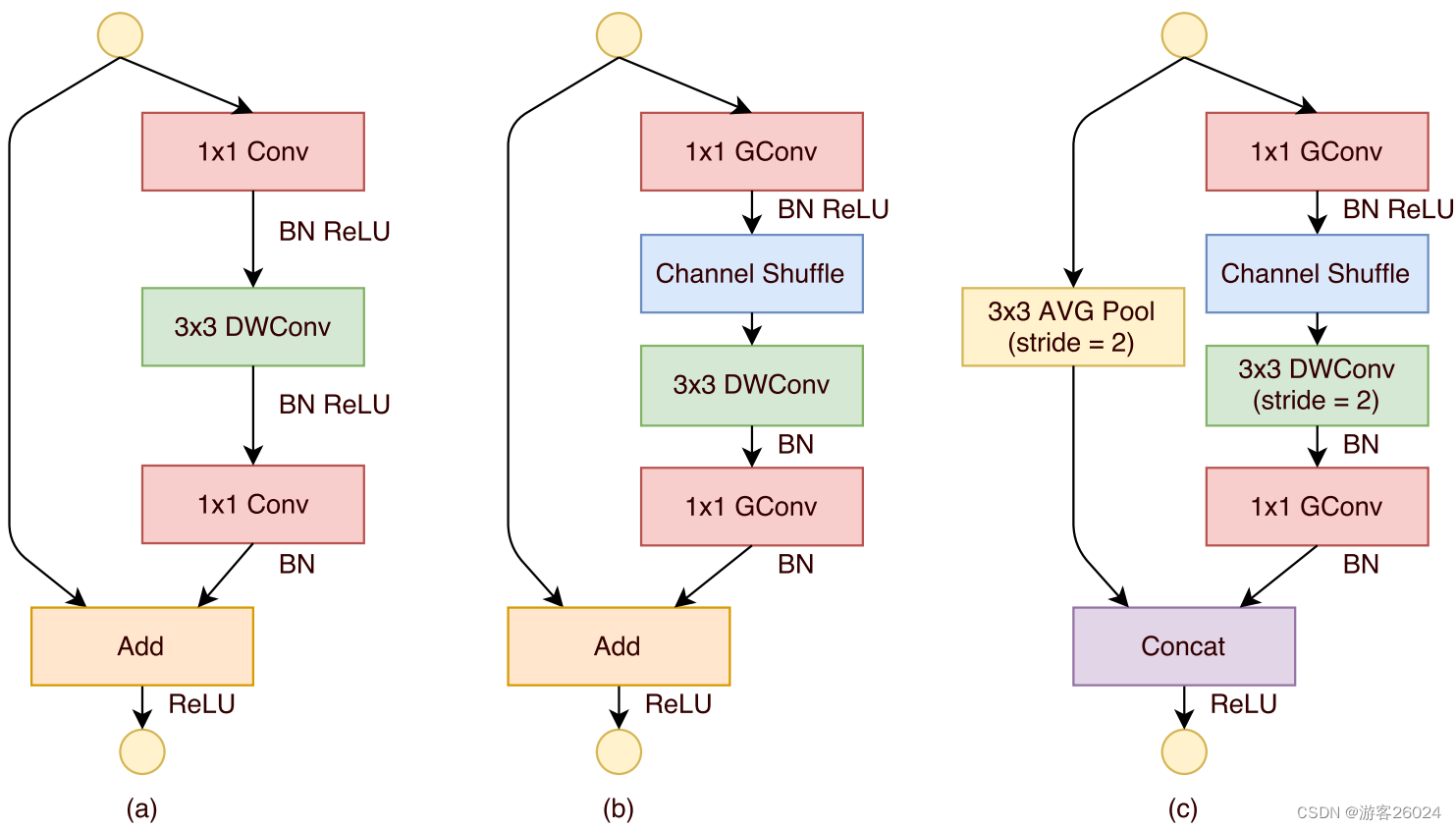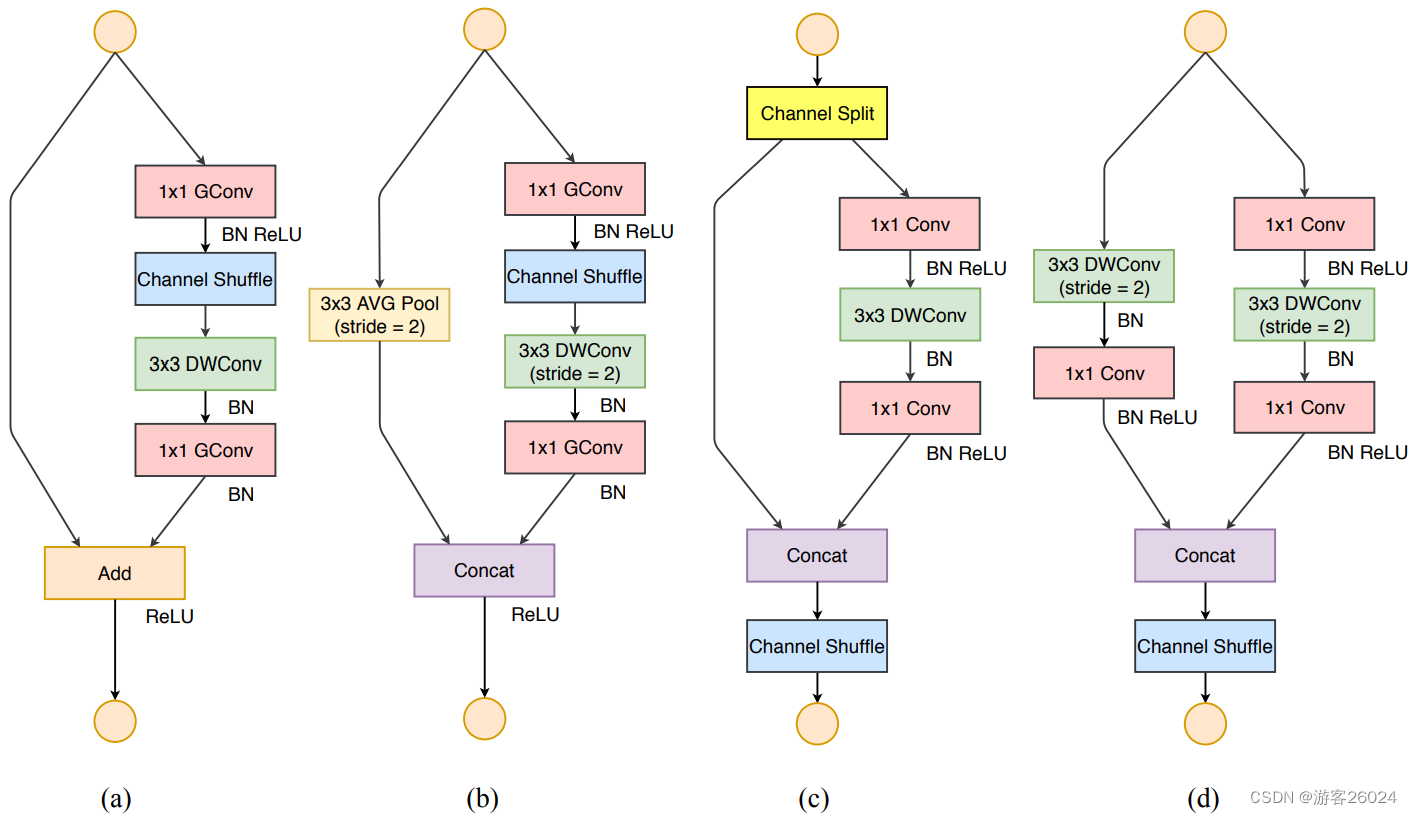上一话
因为没人看,我想弃坑了...
引言此系列重点在于复现计算机视觉(分类、目标检测、语义分割)中深度学习各个经典的网络模型,以便初学者使用(浅入深出)!
代码都运行无误!!
首先复现深度学习的经典分类网络模块,其中专门做目标检测的Backbone(10.,11.)但是它的主要目的是用来提取特征所以也放在这里,有:
1.LeNet5(√,一)
2.VGG(√,一)
3.AlexNet(√,一)
4.ResNet(√,一)
5.ResNeXt(√,二)
6.GoogLeNet(√,二)
7.MobileNet(√)
8.ShuffleNet(√)
9.EfficientNet(√)
10.VovNet
11.DarkNet
...
代码:
7.MobileNet
7.3 MoblieNet v3[9]
首先,复现到倒残差模块,如图 1. 。
1x1 conv 升维
3x3 conv DepthWise
(SE 通道注意机制)
1x1 conv 降维
其一层conv结构为ConvBNAvtivation。
class ConvBNActivation(nn.Sequential):
def __init__(self, norm_layer, activation_layer, in_planes, out_planes, kernel_size=3, stride=1, groups=1):
padding = (kernel_size - 1) // 2
if norm_layer is None:
norm_layer = nn.BatchNorm2d
if activation_layer is None:
activation_layer = nn.ReLU6
super(ConvBNActivation, self).__init__(
nn.Conv2d(in_channels=in_planes, out_channels=out_planes,
kernel_size=kernel_size, stride=stride, padding=padding,
groups=groups, bias=False),
norm_layer(out_planes),
activation_layer())SE通道注意力机制(adv_avg_pool->fc(channles/4)->relu->fc->hardsigmoid)
class SqueezeExcitation(nn.Module):
def __init__(self, input_c, squeeze_factor=4):
super(SqueezeExcitation, self).__init__()
squeeze_c = _make_divisible(input_c // squeeze_factor, 8)
self.fc1 = nn.Conv2d(in_channels=input_c, out_channels=squeeze_c, kernel_size=1)
self.fc2 = nn.Conv2d(in_channels=squeeze_c, out_channels=input_c, kernel_size=1)
@autocast()
def forward(self, x):
scale = F.adaptive_avg_pool2d(x, output_size=(1, 1))
scale = self.fc1(scale)
scale = F.relu(scale)
scale = self.fc2(scale)
scale = F.hardsigmoid(scale)
return scale * x倒残差模块的配置文件
class InvertedResidualConfig:
def __init__(self, input_c, kernel, expanded_c, out_c, use_se, activation, stride, width_multi):
self.input_c = self.adjust_channels(input_c, width_multi)
self.kernel = kernel
self.expanded_c = self.adjust_channels(expanded_c, width_multi)
self.out_c = self.adjust_channels(out_c, width_multi)
self.use_se = use_se
# whether using h-swish activation
self.use_hs = activation == 'HS'
self.stride = stride
@staticmethod
def adjust_channels(channels, width_multi):
return _make_divisible(channels * width_multi, 8)倒残差模块
class InvertedResidual(nn.Module):
def __init__(self, cnf, norm_layer):
super(InvertedResidual, self).__init__()
if cnf.stride not in [1, 2]:
raise ValueError("illegal stride value.")
self.use_res_connect = (cnf.stride == 1 and cnf.input_c == cnf.out_c)
layers = []
activation_layer = nn.Hardswish if cnf.use_hs else nn.ReLU
# expand
if cnf.expanded_c != cnf.input_c:
layers.append(
ConvBNActivation(norm_layer=norm_layer, activation_layer=activation_layer,
in_planes=cnf.input_c, out_planes=cnf.expanded_c, kernel_size=1))
# depthwise
layers.append(
ConvBNActivation(norm_layer=norm_layer, activation_layer=activation_layer,
in_planes=cnf.expanded_c, out_planes=cnf.expanded_c,
kernel_size=cnf.kernel, stride=cnf.stride,
groups=cnf.expanded_c))
if cnf.use_se:
layers.append(SqueezeExcitation(cnf.expanded_c))
# project
layers.append(
ConvBNActivation(norm_layer=norm_layer, activation_layer=nn.Identity,
in_planes=cnf.expanded_c, out_planes=cnf.out_c,
kernel_size=1))
self.block = nn.Sequential(*layers)
self.out_channels = cnf.out_c
self.is_strided = cnf.stride > 1
def forward(self, x):
result = self.block(x)
if self.use_res_connect:
result += x
return result复现MobileNet v3
class mobilenet_v3(nn.Module):
def __init__(self,
inverted_residual_setting,
last_channels, block, norm_layer, num_classes=1000, init_weights=False):
super(mobilenet_v3, self).__init__()
if not inverted_residual_setting:
raise ValueError("The inverted_residual_setting should not be empty.")
elif not (isinstance(inverted_residual_setting, List) and
all([isinstance(s, InvertedResidualConfig) for s in inverted_residual_setting])):
raise TypeError("The inverted_residual_setting should be List[InvertedResidualConfig]")
if block is None:
block = InvertedResidual
if norm_layer is None:
norm_layer = partial(nn.BatchNorm2d, eps=0.001, momentum=0.01)
layers = []
# building first layer
firstconv_output_c = inverted_residual_setting[0].input_c
layers.append(
ConvBNActivation(norm_layer=norm_layer, activation_layer=nn.Hardswish,
in_planes=3, out_planes=firstconv_output_c,
kernel_size=3, stride=2))
# building inverted residual blocks
for cnf in inverted_residual_setting:
layers.append(block(cnf, norm_layer))
# building last several layers
lastconv_input_c = inverted_residual_setting[-1].out_c
lastconv_output_c = 6 * lastconv_input_c
layers.append(
ConvBNActivation(norm_layer=norm_layer, activation_layer=nn.Hardswish,
in_planes=lastconv_input_c, out_planes=lastconv_output_c,
kernel_size=1))
self.features = nn.Sequential(*layers)
self.avgpool = nn.AdaptiveAvgPool2d(1)
self.classifier = nn.Sequential(
nn.Linear(lastconv_output_c, last_channels),
nn.Hardswish(),
nn.Dropout(0.2),
nn.Linear(last_channels, num_classes))
self.init_weights = init_weights
if self.init_weights:
self._initialize_weights()
def _initialize_weights(self):
# initial weights
for m in self.modules():
if isinstance(m, nn.Conv2d):
nn.init.kaiming_normal_(m.weight, mode='fan_out')
if m.bias is not None:
nn.init.zeros_(m.bias)
elif isinstance(m, (nn.BatchNorm2d, nn.GroupNorm)):
nn.init.ones_(m.weight)
nn.init.zeros_(m.bias)
elif isinstance(m, nn.Linear):
nn.init.normal_(m.weight, 0, 0.01)
nn.init.zeros_(m.bias)
def forward(self, x):
x = self.features(x)
x = self.avgpool(x)
x = torch.flatten(x, 1)
x = self.classifier(x)
return x复现MobileNet v3 Large

def mobilenet_v3_large(reduced_tail=False, num_classes=1000, pretrained=False, init_weights=False):
width_multi = 1.0
bneck_conf = partial(InvertedResidualConfig, width_multi=width_multi)
adjust_channels = partial(InvertedResidualConfig.adjust_channels, width_multi=width_multi)
reduce_divider = 2 if reduced_tail else 1
inverted_residual_setting = [
# input_c, kernel, expanded_c, out_c, use_se, activation, stride
bneck_conf(16, 3, 16, 16, False, 'RE', 1),
bneck_conf(16, 3, 64, 24, False, 'RE', 2),
bneck_conf(24, 3, 72, 24, False, 'RE', 1),
bneck_conf(24, 5, 72, 40, True, 'RE', 2),
bneck_conf(40, 5, 120, 40, True, 'RE', 1),
bneck_conf(40, 5, 120, 40, True, 'RE', 1),
bneck_conf(40, 3, 240, 80, False, 'HS', 2),
bneck_conf(80, 3, 200, 80, False, 'HS', 1),
bneck_conf(80, 3, 184, 80, False, 'HS', 1),
bneck_conf(80, 3, 184, 80, False, 'HS', 1),
bneck_conf(80, 3, 480, 112, True, 'HS', 1),
bneck_conf(112, 3, 672, 112, True, 'HS', 1),
bneck_conf(112, 5, 672, 160 // reduce_divider, True, 'HS', 2),
bneck_conf(160 // reduce_divider, 5, 960 // reduce_divider, 160 // reduce_divider, True, 'HS', 1),
bneck_conf(160 // reduce_divider, 5, 960 // reduce_divider, 160 // reduce_divider, True, 'HS', 1),
]
last_channels = adjust_channels(1280 // reduce_divider)
model = mobilenet_v3(inverted_residual_setting=inverted_residual_setting, last_channels=last_channels,
block=None, norm_layer=None, num_classes=num_classes, init_weights=init_weights)
if pretrained:
# if you want to use cpu, you should modify map_loaction=torch.device("cpu")
pretrained_models = torch.load(models_urls['mobilenet_v3_large'], map_location=torch.device("cuda:0"))
# transfer learning
del pretrained_models['features.1.block.0.0.weight']
model.load_state_dict(pretrained_models, strict=False)
return model复现MobileNet v3 Small

def mobilenet_v3_small(reduced_tail=False, num_classes=1000, pretrained=False, init_weights=False):
width_multi = 1.0
bneck_conf = partial(InvertedResidualConfig, width_multi=width_multi)
adjust_channels = partial(InvertedResidualConfig.adjust_channels, width_multi=width_multi)
reduce_divider = 2 if reduced_tail else 1
inverted_residual_setting = [
# input_c, kernel, expanded_c, out_c, use_se, activation, stride
bneck_conf(16, 3, 16, 16, True, 'RE', 2),
bneck_conf(16, 3, 72, 24, False, 'RE', 2),
bneck_conf(24, 3, 88, 24, False, 'RE', 1),
bneck_conf(24, 5, 96, 40, True, 'HS', 2),
bneck_conf(40, 5, 240, 40, True, 'HS', 1),
bneck_conf(40, 5, 240, 40, True, 'HS', 1),
bneck_conf(40, 5, 120, 48, True, 'HS', 1),
bneck_conf(48, 5, 144, 48, True, 'HS', 1),
bneck_conf(48, 5, 288, 96 // reduce_divider, True, 'HS', 2),
bneck_conf(96 // reduce_divider, 5, 576 // reduce_divider, 96 // reduce_divider, True, 'HS', 1),
bneck_conf(96 // reduce_divider, 5, 576 // reduce_divider, 96 // reduce_divider, True, 'HS', 1),
]
last_channels = adjust_channels(1024 // reduce_divider)
model = mobilenet_v3(inverted_residual_setting=inverted_residual_setting, last_channels=last_channels,
block=None, norm_layer=None, num_classes=num_classes, init_weights=init_weights)
if pretrained:
# if you want to use cpu, you should modify map_loaction=torch.device("cpu")
pretrained_models = torch.load(models_urls['mobilenet_v3_small'], map_location=torch.device("cuda:0"))
model.load_state_dict(pretrained_models, strict=False)
return model完整代码
import torch
import torch.nn as nn
from functools import partial
from typing import List
from utils.path import CheckPoints
from torch.cuda.amp import autocast
from torch.nn import functional as F
__all__ = ['mobilenet_v3_large', 'mobilenet_v3_small']
models_urls = {
# 'mobilenet_v3_small' : 'https://download.pytorch.org/models/mobilenet_v3_small-047dcff4.pth'
'mobilenet_v3_small': '{}/mobilenet_v3_small-047dcff4.pth'.format(CheckPoints),
# 'mobilenet_v3_large' : 'https://download.pytorch.org/models/mobilenet_v3_large-8738ca79.pth'
'mobilenet_v3_large': '{}/mobilenet_v3_large-8738ca79.pth'.format(CheckPoints)
}
def MobileNet_v3(pretrained=False, num_classes=1000, init_weights=False, type='small'):
if type == 'small':
return mobilenet_v3_small(pretrained=pretrained, num_classes=num_classes, init_weights=init_weights)
elif type == 'large':
return mobilenet_v3_large(pretrained=pretrained, num_classes=num_classes, init_weights=init_weights)
else:
raise ValueError("Unsupported MobileNet V3 Type!")
def _make_divisible(ch, divisor=8, min_ch=None):
if min_ch is None:
min_ch = divisor
new_ch = max(min_ch, int(ch + divisor / 2) // divisor * divisor)
# Make sure that round down does not go down by more than 10%
if new_ch < 0.9 * ch:
new_ch += divisor
return new_ch
class ConvBNActivation(nn.Sequential):
def __init__(self, norm_layer, activation_layer, in_planes, out_planes, kernel_size=3, stride=1, groups=1):
padding = (kernel_size - 1) // 2
if norm_layer is None:
norm_layer = nn.BatchNorm2d
if activation_layer is None:
activation_layer = nn.ReLU6
super(ConvBNActivation, self).__init__(
nn.Conv2d(in_channels=in_planes, out_channels=out_planes,
kernel_size=kernel_size, stride=stride, padding=padding,
groups=groups, bias=False),
norm_layer(out_planes),
activation_layer())
class SqueezeExcitation(nn.Module):
def __init__(self, input_c, squeeze_factor=4):
super(SqueezeExcitation, self).__init__()
squeeze_c = _make_divisible(input_c // squeeze_factor, 8)
self.fc1 = nn.Conv2d(in_channels=input_c, out_channels=squeeze_c, kernel_size=1)
self.fc2 = nn.Conv2d(in_channels=squeeze_c, out_channels=input_c, kernel_size=1)
@autocast()
def forward(self, x):
scale = F.adaptive_avg_pool2d(x, output_size=(1, 1))
scale = self.fc1(scale)
scale = F.relu(scale)
scale = self.fc2(scale)
scale = F.hardsigmoid(scale)
return scale * x
class InvertedResidualConfig:
def __init__(self, input_c, kernel, expanded_c, out_c, use_se, activation, stride, width_multi):
self.input_c = self.adjust_channels(input_c, width_multi)
self.kernel = kernel
self.expanded_c = self.adjust_channels(expanded_c, width_multi)
self.out_c = self.adjust_channels(out_c, width_multi)
self.use_se = use_se
# whether using h-swish activation
self.use_hs = activation == 'HS'
self.stride = stride
@staticmethod
def adjust_channels(channels, width_multi):
return _make_divisible(channels * width_multi, 8)
class InvertedResidual(nn.Module):
def __init__(self, cnf, norm_layer):
super(InvertedResidual, self).__init__()
if cnf.stride not in [1, 2]:
raise ValueError("illegal stride value.")
self.use_res_connect = (cnf.stride == 1 and cnf.input_c == cnf.out_c)
layers = []
activation_layer = nn.Hardswish if cnf.use_hs else nn.ReLU
# expand
if cnf.expanded_c != cnf.input_c:
layers.append(
ConvBNActivation(norm_layer=norm_layer, activation_layer=activation_layer,
in_planes=cnf.input_c, out_planes=cnf.expanded_c, kernel_size=1))
# depthwise
layers.append(
ConvBNActivation(norm_layer=norm_layer, activation_layer=activation_layer,
in_planes=cnf.expanded_c, out_planes=cnf.expanded_c,
kernel_size=cnf.kernel, stride=cnf.stride,
groups=cnf.expanded_c))
if cnf.use_se:
layers.append(SqueezeExcitation(cnf.expanded_c))
# project
layers.append(
ConvBNActivation(norm_layer=norm_layer, activation_layer=nn.Identity,
in_planes=cnf.expanded_c, out_planes=cnf.out_c,
kernel_size=1))
self.block = nn.Sequential(*layers)
self.out_channels = cnf.out_c
self.is_strided = cnf.stride > 1
def forward(self, x):
result = self.block(x)
if self.use_res_connect:
result += x
return result
class mobilenet_v3(nn.Module):
def __init__(self,
inverted_residual_setting,
last_channels, block, norm_layer, num_classes=1000, init_weights=False):
super(mobilenet_v3, self).__init__()
if not inverted_residual_setting:
raise ValueError("The inverted_residual_setting should not be empty.")
elif not (isinstance(inverted_residual_setting, List) and
all([isinstance(s, InvertedResidualConfig) for s in inverted_residual_setting])):
raise TypeError("The inverted_residual_setting should be List[InvertedResidualConfig]")
if block is None:
block = InvertedResidual
if norm_layer is None:
norm_layer = partial(nn.BatchNorm2d, eps=0.001, momentum=0.01)
layers = []
# building first layer
firstconv_output_c = inverted_residual_setting[0].input_c
layers.append(
ConvBNActivation(norm_layer=norm_layer, activation_layer=nn.Hardswish,
in_planes=3, out_planes=firstconv_output_c,
kernel_size=3, stride=2))
# building inverted residual blocks
for cnf in inverted_residual_setting:
layers.append(block(cnf, norm_layer))
# building last several layers
lastconv_input_c = inverted_residual_setting[-1].out_c
lastconv_output_c = 6 * lastconv_input_c
layers.append(
ConvBNActivation(norm_layer=norm_layer, activation_layer=nn.Hardswish,
in_planes=lastconv_input_c, out_planes=lastconv_output_c,
kernel_size=1))
self.features = nn.Sequential(*layers)
self.avgpool = nn.AdaptiveAvgPool2d(1)
self.classifier = nn.Sequential(
nn.Linear(lastconv_output_c, last_channels),
nn.Hardswish(),
nn.Dropout(0.2),
nn.Linear(last_channels, num_classes))
self.init_weights = init_weights
if self.init_weights:
self._initialize_weights()
def _initialize_weights(self):
# initial weights
for m in self.modules():
if isinstance(m, nn.Conv2d):
nn.init.kaiming_normal_(m.weight, mode='fan_out')
if m.bias is not None:
nn.init.zeros_(m.bias)
elif isinstance(m, (nn.BatchNorm2d, nn.GroupNorm)):
nn.init.ones_(m.weight)
nn.init.zeros_(m.bias)
elif isinstance(m, nn.Linear):
nn.init.normal_(m.weight, 0, 0.01)
nn.init.zeros_(m.bias)
def forward(self, x):
x = self.features(x)
x = self.avgpool(x)
x = torch.flatten(x, 1)
x = self.classifier(x)
return x
def mobilenet_v3_large(reduced_tail=False, num_classes=1000, pretrained=False, init_weights=False):
width_multi = 1.0
bneck_conf = partial(InvertedResidualConfig, width_multi=width_multi)
adjust_channels = partial(InvertedResidualConfig.adjust_channels, width_multi=width_multi)
reduce_divider = 2 if reduced_tail else 1
inverted_residual_setting = [
# input_c, kernel, expanded_c, out_c, use_se, activation, stride
bneck_conf(16, 3, 16, 16, False, 'RE', 1),
bneck_conf(16, 3, 64, 24, False, 'RE', 2),
bneck_conf(24, 3, 72, 24, False, 'RE', 1),
bneck_conf(24, 5, 72, 40, True, 'RE', 2),
bneck_conf(40, 5, 120, 40, True, 'RE', 1),
bneck_conf(40, 5, 120, 40, True, 'RE', 1),
bneck_conf(40, 3, 240, 80, False, 'HS', 2),
bneck_conf(80, 3, 200, 80, False, 'HS', 1),
bneck_conf(80, 3, 184, 80, False, 'HS', 1),
bneck_conf(80, 3, 184, 80, False, 'HS', 1),
bneck_conf(80, 3, 480, 112, True, 'HS', 1),
bneck_conf(112, 3, 672, 112, True, 'HS', 1),
bneck_conf(112, 5, 672, 160 // reduce_divider, True, 'HS', 2),
bneck_conf(160 // reduce_divider, 5, 960 // reduce_divider, 160 // reduce_divider, True, 'HS', 1),
bneck_conf(160 // reduce_divider, 5, 960 // reduce_divider, 160 // reduce_divider, True, 'HS', 1),
]
last_channels = adjust_channels(1280 // reduce_divider)
model = mobilenet_v3(inverted_residual_setting=inverted_residual_setting, last_channels=last_channels,
block=None, norm_layer=None, num_classes=num_classes, init_weights=init_weights)
if pretrained:
# if you want to use cpu, you should modify map_loaction=torch.device("cpu")
pretrained_models = torch.load(models_urls['mobilenet_v3_large'], map_location=torch.device("cuda:0"))
# transfer learning
del pretrained_models['features.1.block.0.0.weight']
model.load_state_dict(pretrained_models, strict=False)
return model
def mobilenet_v3_small(reduced_tail=False, num_classes=1000, pretrained=False, init_weights=False):
width_multi = 1.0
bneck_conf = partial(InvertedResidualConfig, width_multi=width_multi)
adjust_channels = partial(InvertedResidualConfig.adjust_channels, width_multi=width_multi)
reduce_divider = 2 if reduced_tail else 1
inverted_residual_setting = [
# input_c, kernel, expanded_c, out_c, use_se, activation, stride
bneck_conf(16, 3, 16, 16, True, 'RE', 2),
bneck_conf(16, 3, 72, 24, False, 'RE', 2),
bneck_conf(24, 3, 88, 24, False, 'RE', 1),
bneck_conf(24, 5, 96, 40, True, 'HS', 2),
bneck_conf(40, 5, 240, 40, True, 'HS', 1),
bneck_conf(40, 5, 240, 40, True, 'HS', 1),
bneck_conf(40, 5, 120, 48, True, 'HS', 1),
bneck_conf(48, 5, 144, 48, True, 'HS', 1),
bneck_conf(48, 5, 288, 96 // reduce_divider, True, 'HS', 2),
bneck_conf(96 // reduce_divider, 5, 576 // reduce_divider, 96 // reduce_divider, True, 'HS', 1),
bneck_conf(96 // reduce_divider, 5, 576 // reduce_divider, 96 // reduce_divider, True, 'HS', 1),
]
last_channels = adjust_channels(1024 // reduce_divider)
model = mobilenet_v3(inverted_residual_setting=inverted_residual_setting, last_channels=last_channels,
block=None, norm_layer=None, num_classes=num_classes, init_weights=init_weights)
if pretrained:
# if you want to use cpu, you should modify map_loaction=torch.device("cpu")
pretrained_models = torch.load(models_urls['mobilenet_v3_small'], map_location=torch.device("cuda:0"))
model.load_state_dict(pretrained_models, strict=False)
return model8.ShuffleNet
8.1.ShuffleNet v1[10]
不复现,理解其创新
首先,Channels对于普通的GConv操作来说如图 4.(a),是针对组内的Channels进行串行堆叠,而对于不同组之前没有信息交流,这样效果不好
改进之后,如图 4.(b)假设我们的group采用了3组,红绿蓝;将每一组得到的特征进行进一步划分,将每一组的第一份放在一起,第二份放在一起,第三份放在一起如图4.(c),这样的feature map融合了不同组之间的信息

因为ResNeXt中的block的pwConv(1x1 Conv)占据了计算量的93.4%,改进之后的block如图 5.(b),(c)1x1 Conv改为1x1GConv,其中图 5.(b)stride为1 图5.(c)stride为2

ShuffleNet v1完整版,如图 6.

8.2.ShuffleNet v2[11]
FLOPs:注意s小写,表示为可以用来衡量 算法 或者 模型 的 复杂度
但是,计算深度学习网络的复杂度不能只看FLOP,还和memory access cost(MAC)内存访问花销等有关,ShuffleNet v2提出了四条网络结构设计准则:(具体证明看论文)
G1: Equal channel width minimizes memory access cost (MAC)当 卷积层的输入特征矩阵与输出特征矩阵channels相等 时 且 FLOPs保持不变,内访问花销最小。 如图 7., c1与c2的比例为1:1时,GPU和ARM的速度最快。

G2: Excessive group convolution increases MAC当GConv的组(group)增大时 且 保持FLOPs不变,内存的访问花销也会增大。如图 8. ,g越小,GPU和CPU的访问速度就越大。

G3: Network fragmentation reduces degree of parallelism网络设计的碎片化程度越高,GPU与CPU的访问速度越慢。如图 9.,1-fragment可能表示只有一层的卷积层,2-fragment-series可能表示有两层的卷积层串行,4-fragment-series可能表示有四层的卷积层串行;2-fragment-parallel可能表示有两层的卷积层并行,4-fragment-parallel可能表示有四层的卷积层并行。

G4: Element-wise operations are non-negligibleElement-wise(ReLU,short-cut)操作带来的影响是不可忽略的。如图 10.,ReLU与short-cut越少使用,GPU与CPU的访问速度越快。

根据以上的四条网络架构设计准则,设计出的block如图 11.(c),(d),复现如下

首先复现图 11.(c)中的channel shuffle,就是将channel按照准则G1对半分
def channel_shuffle(x, groups):
batch_size, num_channels, height, width = x.shape
channels_per_group = num_channels // groups
# reshape
# [batch_size, num_channels, height, width] -> [batch_size, group, channels_per_group, height, width]
x = x.view(batch_size, groups, channels_per_group, height, width)
x = torch.transpose(x, 1, 2).contiguous()
# flatten
x = x.view(batch_size, -1, height, width)
return x复现block,按照准则G2将g设为1,G3将fragment设置成越来越少的,如图11.(c),(d),以前的ReLU是两分支都执行,按照准则G4一条分支执行ReLU
class InvertedResidual(nn.Module):
def __init__(self, input_c, output_c, stride):
super(InvertedResidual, self).__init__()
if stride not in [1, 2]:
raise ValueError("illegal stride value.")
self.stride = stride
assert output_c % 2 == 0
branch_features = output_c // 2
# << -> x2
assert (self.stride != 1) or (input_c == branch_features << 1)
if self.stride == 2:
self.branch1 = nn.Sequential(
self.depthwise_conv(input_c, input_c, kernel_size=3, stride=self.stride, padding=1),
nn.BatchNorm2d(input_c),
nn.Conv2d(input_c, branch_features, kernel_size=1, stride=1, padding=0, bias=False),
nn.BatchNorm2d(branch_features),
nn.ReLU()
)
else:
self.branch1 = nn.Sequential()
self.branch2 = nn.Sequential(
nn.Conv2d(input_c if self.stride > 1 else branch_features, branch_features, kernel_size=1,
stride=1, padding=0, bias=False),
nn.BatchNorm2d(branch_features),
nn.ReLU(),
self.depthwise_conv(branch_features, branch_features, kernel_size=3, stride=self.stride, padding=1),
nn.BatchNorm2d(branch_features),
nn.Conv2d(branch_features, branch_features, kernel_size=1, stride=1, padding=0, bias=False),
nn.BatchNorm2d(branch_features),
nn.ReLU()
)
@staticmethod
def depthwise_conv(input_c, ouptput_c, kernel_size, stride, padding=0, bias=False):
return nn.Conv2d(in_channels=input_c, out_channels=ouptput_c, kernel_size=kernel_size,
stride=stride, padding=padding, bias=bias, groups=input_c)
@autocast()
def forward(self, x):
if self.stride == 1:
x1, x2 = x.chunk(2, dim=1)
out = torch.cat((x1, self.branch2(x2)), dim=1)
else:
out = torch.cat((self.branch1(x), self.branch2(x)), dim=1)
out = channel_shuffle(out, 2)
return out复现shufflenet v2,如图 12.

class ShuffleNetV2(nn.Module):
def __init__(self, stages_repeats, stages_out_channels, inverted_residual=InvertedResidual, num_classes=1000):
super(ShuffleNetV2, self).__init__()
if len(stages_repeats) != 3:
raise ValueError("expected stages_repeats as list of 3 positive ints")
if len(stages_out_channels) != 5:
raise ValueError("expected stages_out_channels as list of 5 positive ints")
self._stage_out_channels = stages_out_channels
# input RGB image
input_channels = 3
output_channels = self._stage_out_channels[0]
self.conv1 = nn.Sequential(
nn.Conv2d(input_channels, output_channels, kernel_size=3, stride=2, padding=1, bias=False),
nn.BatchNorm2d(output_channels),
nn.ReLU()
)
input_channels = output_channels
self.maxpool = nn.MaxPool2d(kernel_size=3, stride=2, padding=1)
# Static annotations
self.stage2: nn.Sequential
self.stage3: nn.Sequential
self.stage4: nn.Sequential
stage_names = ["stage{}".format(i) for i in [2, 3, 4]]
for name, repeats, output_channels in zip(stage_names, stages_repeats, self._stage_out_channels[1:]):
seq = [inverted_residual(input_channels, output_channels, 2)]
for i in range(repeats - 1):
seq.append(inverted_residual(output_channels, output_channels, 1))
setattr(self, name, nn.Sequential(*seq))
input_channels = output_channels
output_channels = self._stage_out_channels[-1]
self.conv5 = nn.Sequential(
nn.Conv2d(input_channels, output_channels, kernel_size=1, stride=1, padding=0, bias=False),
nn.BatchNorm2d(output_channels),
nn.ReLU()
)
self.fc = nn.Linear(output_channels, num_classes)
@autocast()
def forward(self, x):
x = self.conv1(x)
x = self.maxpool(x)
x = self.stage2(x)
x = self.stage3(x)
x = self.stage4(x)
x = self.conv5(x)
x = x.mean([2, 3])
x = self.fc(x)
return x
def shufflenet_v2_x0_5(num_classes=1000, pretrained=False):
return shufflenet_v2_x('0_5', stages_repeats=[4, 8, 4], stages_out_channels=[24, 48, 96, 192, 1024],
num_classes=num_classes, pretrained=pretrained)
def shufflenet_v2_x1_0(num_classes=1000, pretrianed=False):
return shufflenet_v2_x('1_0', stages_repeats=[4, 8, 4], stages_out_channels=[24, 116, 232, 464, 1024],
num_classes=num_classes, pretrianed=pretrianed)
def shufflenet_v2_x1_5(num_classes=1000, pretrained=False):
return shufflenet_v2_x('1_5', stages_repeats=[4, 8, 4], stages_out_channels=[24, 176, 352, 704, 1024],
num_classes=num_classes, pretrained=pretrained)
def shufflenet_v2_x2_0(num_classes=1000, pretrained=False):
return shufflenet_v2_x('2_0', stages_repeats=[4, 8, 4], stages_out_channels=[24, 244, 488, 976, 2048],
num_classes=num_classes, pretrained=pretrained)完整代码
import torch
from torch import nn
from utils.path import CheckPoints
from torch.cuda.amp import autocast
__all__ = [
'shufflenet_v2_x0_5',
'shufflenet_v2_x1_0',
'shufflenet_v2_x1_5',
'shufflenet_v2_x2_0',
]
model_urls = {
# 'shufflenet_v2_x0_5': 'https://download.pytorch.org/models/shufflenetv2_x0.5-f707e7126e.pth',
'shufflenet_v2_x0_5': '{}/shufflenetv2_x0.5-f707e7126e.pth'.format(CheckPoints),
# 'shufflenet_v2_x1_0': 'https://download.pytorch.org/models/shufflenetv2_x1-5666bf0f80.pth',
'shufflenet_v2_x1_0': '{}/shufflenetv2_x1-5666bf0f80.pth'.format(CheckPoints),
# 'shufflenet_v2_x1_5': 'https://download.pytorch.org/models/shufflenetv2_x1_5-3c479a10.pth',
'shufflenet_v2_x1_5': '{}/shufflenetv2_x1_5-3c479a10.pth'.format(CheckPoints),
# 'shufflenet_v2_x2_0': 'https://download.pytorch.org/models/shufflenetv2_x2_0-8be3c8ee.pth',
'shufflenet_v2_x2_0': '{}/shufflenetv2_x2_0-8be3c8ee.pth'.format(CheckPoints),
}
def shufflenet_v2_x(arch, stages_repeats, stages_out_channels, num_classes, pretrained, **kwargs):
model = ShuffleNetV2(stages_repeats, stages_out_channels, num_classes=num_classes, **kwargs)
if pretrained:
pretrained_models = torch.load(model_urls['shufflenet_v2_x' + arch], map_location=torch.device("cuda:0"))
model.load_state_dict(pretrained_models, strict=False)
return model
def channel_shuffle(x, groups):
batch_size, num_channels, height, width = x.shape
channels_per_group = num_channels // groups
# reshape
# [batch_size, num_channels, height, width] -> [batch_size, group, channels_per_group, height, width]
x = x.view(batch_size, groups, channels_per_group, height, width)
x = torch.transpose(x, 1, 2).contiguous()
# flatten
x = x.view(batch_size, -1, height, width)
return x
class InvertedResidual(nn.Module):
def __init__(self, input_c, output_c, stride):
super(InvertedResidual, self).__init__()
if stride not in [1, 2]:
raise ValueError("illegal stride value.")
self.stride = stride
assert output_c % 2 == 0
branch_features = output_c // 2
# << -> x2
assert (self.stride != 1) or (input_c == branch_features << 1)
if self.stride == 2:
self.branch1 = nn.Sequential(
self.depthwise_conv(input_c, input_c, kernel_size=3, stride=self.stride, padding=1),
nn.BatchNorm2d(input_c),
nn.Conv2d(input_c, branch_features, kernel_size=1, stride=1, padding=0, bias=False),
nn.BatchNorm2d(branch_features),
nn.ReLU()
)
else:
self.branch1 = nn.Sequential()
self.branch2 = nn.Sequential(
nn.Conv2d(input_c if self.stride > 1 else branch_features, branch_features, kernel_size=1,
stride=1, padding=0, bias=False),
nn.BatchNorm2d(branch_features),
nn.ReLU(),
self.depthwise_conv(branch_features, branch_features, kernel_size=3, stride=self.stride, padding=1),
nn.BatchNorm2d(branch_features),
nn.Conv2d(branch_features, branch_features, kernel_size=1, stride=1, padding=0, bias=False),
nn.BatchNorm2d(branch_features),
nn.ReLU()
)
@staticmethod
def depthwise_conv(input_c, ouptput_c, kernel_size, stride, padding=0, bias=False):
return nn.Conv2d(in_channels=input_c, out_channels=ouptput_c, kernel_size=kernel_size,
stride=stride, padding=padding, bias=bias, groups=input_c)
@autocast()
def forward(self, x):
if self.stride == 1:
x1, x2 = x.chunk(2, dim=1)
out = torch.cat((x1, self.branch2(x2)), dim=1)
else:
out = torch.cat((self.branch1(x), self.branch2(x)), dim=1)
out = channel_shuffle(out, 2)
return out
class ShuffleNetV2(nn.Module):
def __init__(self, stages_repeats, stages_out_channels, inverted_residual=InvertedResidual, num_classes=1000):
super(ShuffleNetV2, self).__init__()
if len(stages_repeats) != 3:
raise ValueError("expected stages_repeats as list of 3 positive ints")
if len(stages_out_channels) != 5:
raise ValueError("expected stages_out_channels as list of 5 positive ints")
self._stage_out_channels = stages_out_channels
# input RGB image
input_channels = 3
output_channels = self._stage_out_channels[0]
self.conv1 = nn.Sequential(
nn.Conv2d(input_channels, output_channels, kernel_size=3, stride=2, padding=1, bias=False),
nn.BatchNorm2d(output_channels),
nn.ReLU()
)
input_channels = output_channels
self.maxpool = nn.MaxPool2d(kernel_size=3, stride=2, padding=1)
# Static annotations
self.stage2: nn.Sequential
self.stage3: nn.Sequential
self.stage4: nn.Sequential
stage_names = ["stage{}".format(i) for i in [2, 3, 4]]
for name, repeats, output_channels in zip(stage_names, stages_repeats, self._stage_out_channels[1:]):
seq = [inverted_residual(input_channels, output_channels, 2)]
for i in range(repeats - 1):
seq.append(inverted_residual(output_channels, output_channels, 1))
setattr(self, name, nn.Sequential(*seq))
input_channels = output_channels
output_channels = self._stage_out_channels[-1]
self.conv5 = nn.Sequential(
nn.Conv2d(input_channels, output_channels, kernel_size=1, stride=1, padding=0, bias=False),
nn.BatchNorm2d(output_channels),
nn.ReLU()
)
self.fc = nn.Linear(output_channels, num_classes)
@autocast()
def forward(self, x):
x = self.conv1(x)
x = self.maxpool(x)
x = self.stage2(x)
x = self.stage3(x)
x = self.stage4(x)
x = self.conv5(x)
x = x.mean([2, 3])
x = self.fc(x)
return x
def shufflenet_v2_x0_5(num_classes=1000, pretrained=False):
return shufflenet_v2_x('0_5', stages_repeats=[4, 8, 4], stages_out_channels=[24, 48, 96, 192, 1024],
num_classes=num_classes, pretrained=pretrained)
def shufflenet_v2_x1_0(num_classes=1000, pretrianed=False):
return shufflenet_v2_x('1_0', stages_repeats=[4, 8, 4], stages_out_channels=[24, 116, 232, 464, 1024],
num_classes=num_classes, pretrianed=pretrianed)
def shufflenet_v2_x1_5(num_classes=1000, pretrained=False):
return shufflenet_v2_x('1_5', stages_repeats=[4, 8, 4], stages_out_channels=[24, 176, 352, 704, 1024],
num_classes=num_classes, pretrained=pretrained)
def shufflenet_v2_x2_0(num_classes=1000, pretrained=False):
return shufflenet_v2_x('2_0', stages_repeats=[4, 8, 4], stages_out_channels=[24, 244, 488, 976, 2048],
num_classes=num_classes, pretrained=pretrained)9. EfficientNet
有缘就写...
运行结果
7.MobileNet v3
(1) large
basenet: MobileNet_v3_large
dataset: ImageNet
batch_size: 32
optim: SGD
lr: 0.001
momentum: 0.9
weight_decay: 1e-4
scheduler: ReduceLROnPlateau
patience: 2
epoch: 30
pretrained: True
| No.epoch | times/epoch | top1 acc (%) | top5 acc (%) |
|---|---|---|---|
| 5 | 3h58min13s | 71.15 | 90.32 |
(2) small
basenet: MobileNet_v3_small
dataset: ImageNet
batch_size: 32
optim: SGD
lr: 0.001
momentum: 0.9
weight_decay: 1e-4
scheduler: ReduceLROnPlateau
patience: 2
epoch: 30
pretrained: True| No.epoch | times/epoch | top1 acc (%) | top5 acc (%) |
|---|---|---|---|
| 5 | 3h54min38s | 68.89 | 88.92 |
8.ShuffleNet v2
basenet: ShuffleNet_v2_x0_5
dataset: ImageNet
batch_size: 32
optim: SGD
lr: 0.001
momentum: 0.9
weight_decay: 1e-4
scheduler: ReduceLROnPlateau
patience: 2
epoch: 30
pretrained: True| No.epoch | times/epoch | top1 acc (%) | top5 acc (%) |
|---|---|---|---|
| 5 | 3h52min0s | 55.61 | 78.84 |